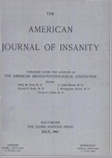Abstract
1. Forty-two cases unanimously diagnosed "senile dementia" at the Danvers Hospital clinics have been reviewed clinically and anatomically, with a surprisingly low general percentage of accuracy (66 per cent) where either cerebral atrophy or cortical arteriosclerosis or both were regarded as confirmatory, and with still lower percentages: (48 per cent) where cortical arteriosclerosis was considered essential and (38 per cent) where cerebral atrophy was considered essential for a correct diagnosis.
2. The 14 cases which showed neither cerebral atrophy nor cortical arteriosclerosis (with obvious damage to the cortical tissues) are cases which probably should not have been termed senile dementia, and perhaps more properly belong in a group of acute psychoses or other mental diseases occurring in old age but not dependent on recognizable senile changes.
3. Of the residuum, it is clear that cases in which cerebral atrophy and cortical arteriosclerosis are combined are not suitable for exact study, and attention has been concentrated upon eight cases of relatively pure brain atrophy, regarded as representing more nearly genuine senile dementia than the arteriosclerotic cases, which should be classed under the head of organic dementia.
4. True senile or senile atrophic dementia includes 1) cases in which the loss in brain weight proceeds pari passu with a general loss of weight in the other viscera and 2) cases in which the loss in weight of the nerve tissues is differential.
5. The mental diseases of old age, therefore, include
(a) mental diseases occurring in, but not characteristic of, old age;
(b) organic dementias due to cortical arteriosclerosis;
(c) senile atrophic dementias, attended with
(1) general visceral atrophy,
(2) differential atrophy of the nerve tissues.
6. Obvious suggestions for research in the two groups of senile atrophic dementias as above stated are that the phenomena of general visceral atrophy may depend upon general decadent agencies (dehydration?) and that the more differential atrophy indicates special metabolic flaws or toxic agencies.
7. Since such a grouping has not been hitherto rigorously borne in mind, it is not possible to state the clinical features of these cases in detail.
8. Taking the group senile atrophic dementia as a whole, we find all the eight cases female, without special indications of inheritance, with very various antecedent factors (social factors not prominent), all markedly defective in vision (though for a considerable variety of reasons), often defective in hearing, all subject to various degrees of arteriosclerosis (in some instances not clinically made out), all showing the characteristic external signs of senility, and all showing either chronic diffuse nephritis (interstitial type predominant) or renal arteriosclerosis.
9. Neurologically, the eight cases showed characteristically tremors, absence of certain superficial reflexes, variations in some deep reflexes (tendency to loss of leg reflexes), defective organic reflexes, alterations of gait, and occasional slight speech disorder.
10. Psychiatrically, communication with the patients is difficult and impressibility or general perceptual capacity is deficient. The amnesia for recent events is characteristic and constant. The patients are perhaps unoriented rather than disoriented. Amnesia for remote events is also frequently present. Delusions are not prominent. Visual or auditory hallucinations (or illusions) characterized some cases. Motor excitement and nightly restlessness and noise are characteristic, though not quite constant, and are not in all cases certainly due to hallucinations. Garrulity was surprisingly uncommon in this group.
11. Anatomically the pia mater was in general remarkably free from chronic changes, and, as the condition of the vessels was the basis of selection of the cases, the vessels naturally showed nothing grossly beyond involvement of the larger or pipe arteries (basal cerebral arteriosclerosis). The cerebral wasting was not in all cases quite uniform. One case even showed a slight granular ependymitis. The consistence of the brain tissue was in general increased.
12. A high percentage of obsolete tuberculosis characterized the autopsies.
13. Aortic sclerosis is probably constant in these cases. Sclerosis of other vessels is frequent but variable. The constancy of renal changes is interesting.
14. The cause of death is pulmonary in many cases, and is perhaps in some way bacterial in all.
15. No intensive microscopic examination has been undertaken, as the object has been rather to define the group of senile atrophic dementias. The satellite cell findings are consistent with Metchnikoff's hypothesis concerning phagocytic processes in old age. It is believed, however, that cell and fiber changes are very probably primary and "neuronophagia" secondary, or at any rate that these processes run pari passu.
16. A few cases showed satellite cells preferring the apical cell processes rather than the basal regions of the pyromidal cells.
17. It is alleged that no convincing evidence has been brought of a causal relation between local vascular changes and diffuse senile nerve cell atrophy.

